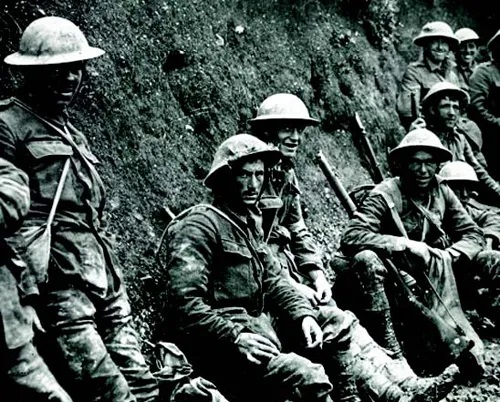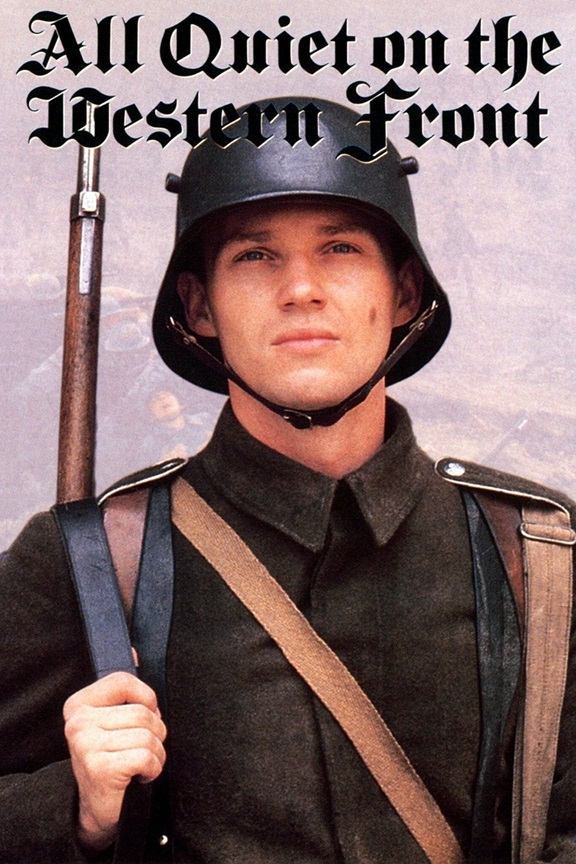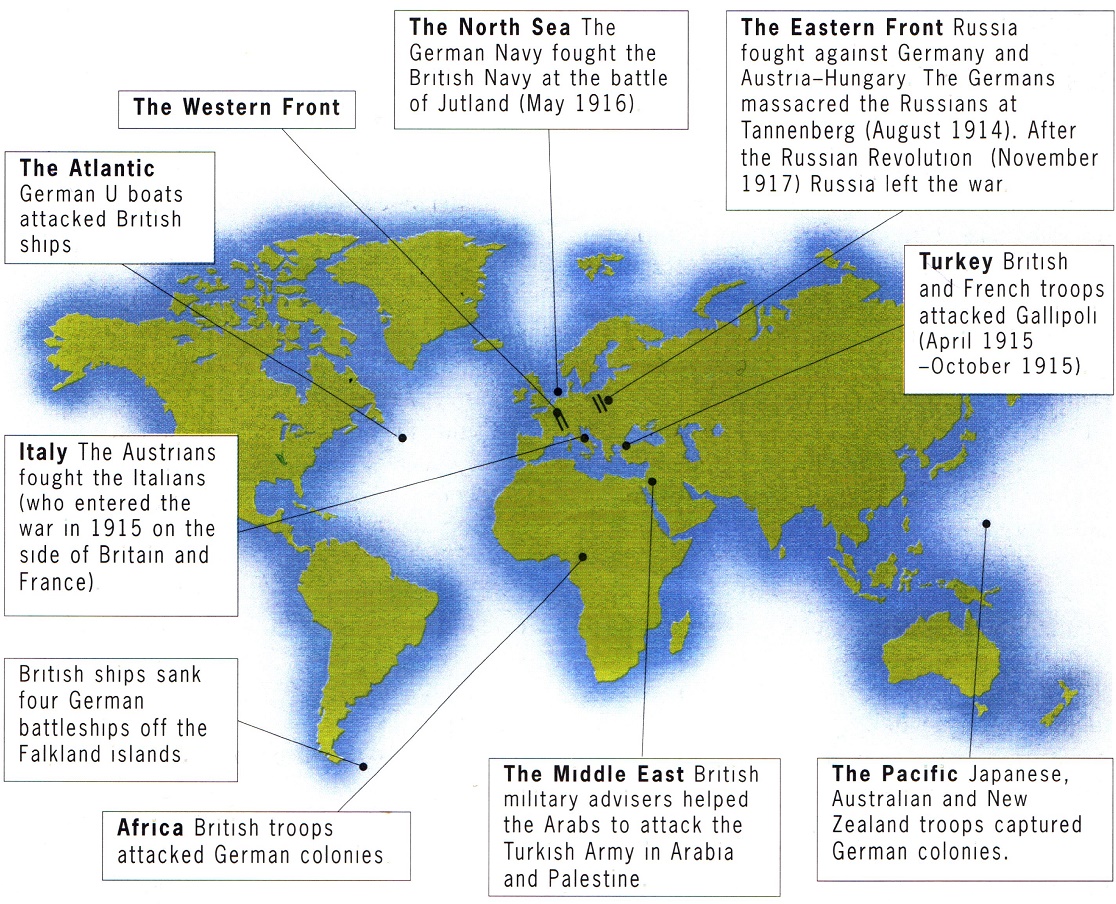|
|
|
|
Mud, sleet, ice, mud, noise, jagged steel, horror piled on reeking horror.
|
Going DeeperThe following links will help you widen your knowledge:
Animated maps of the Western Front:
Film and Youtube
Documents and pictures: 7 World War One poems
Harry Lamin's letters - fascinating
Document Archive - HUGE,
will probably overwhelm you Podcast: Interpretations: Misrepresentation of a Conflict
- Dr Dan Todman argues that it WASN'T a pointless 'killing fields' (pdf) |
1914
Western FrontThe ‘War of Movement’ In August 1914 the German army, following the Schlieffen Plan, advanced into Belgium and France. Things did not go as planned. The Belgians held them up at Liege (5-16 August), and the British Expeditionary Force (BEF) inflicted heavy losses at the Battle of Mons (23 August). The German Army began to tire, and there were problems with their supply lines.
Eastern FrontIn the east, the Russian army mobilised much quicker than expected, and invaded Germany. The Russians were poorly-equipped and badly-led, and the German army slaughtered them at the battle of Tannenberg (26-29 August). But the Germans had had to divert men from the western front to do so, which further damaged the Schlieffen attack. Turkey joined the war on the side of the Germans; this closed the Straits between the Black Sea and the Mediterranean (which cut off the Russians from Allied help) and led to fighting in the Middle East.
Western FrontThe defeat of the Schlieffen Plan ‘Race to the Sea’ With the Schlieffen Plan stuttering, the German Generals re-directed their First Army east on a shorter route towards Paris. It was a disastrous decision; the French drove into the gap this created, and stopped the German advance at the Battle of the Marne (5-10 September). Both sides dug trenches to protect themselves. The ‘Race to the Sea’ After the Battle of the Marne, both sides then tried to outflank the other, both digging trenches to prevent themselves being outflanked. By the end of November the two sides were facing each other from a line of trenches which ran from the English Channel to Switzerland (700 km).
|
|
1915
Western FrontAttempts to Break Through The war became a deadly stalemate. Men advancing on foot with rifles, were met with machine guns, whilst trains rushed extra soldiers to the trouble spots. For a while, Britain and France continued believing they could break through. But at the Second Battle of Ypres (April-May 1915) and the Battle of Loos (September-October 1915) they suffered massive casualties.
Eastern FrontIn January 1915, the Germans decided to hold the line on the Western Front, and concentrate on the Eastern Front; the Russians were defeated and forced back.
GallipoliIn Britain, faced by the stalemate on the western front, Winston Churchill persuaded the government to open a second front in Turkey (March-December 1915). It was a humiliation. The British, with troops from Australia and New Zealand (the ANZACs) landed at Gallipoli but were defeated, with 57,000 dead and 124,000 wounded.
|
|
1916
Western FrontThe War of Attrition The Germans now came up with the idea of ‘attrition’ – to fight, whatever the losses, until their enemies were ‘worn down’. So 1916 saw two of the biggest and most costly battles of the war – the battles of Verdun (February–December 1916) and the Somme (July–November 1916; the battle where the British first used tanks). Figures are disputed, but you are looking at perhaps 1ľ million total casualties of which 600,000 dead.
Eastern FrontThe Russians attacked the Austrians and drove them back, but the offensive failed when the Germans intervened.
War at SeaIn 1914, the British navy had blockaded Germany on the outbreak of war. In May 1916 the German navy came out from port to confront it at the battle of Jutland. Although the Germans won the battle, they failed to break the blockade; historians disagree whether this ‘won the war’, the blockade certainly inflicted great hardships upon the German population.
|
Source A
The film All Quiet on the Western Front was based on the book by Erich Maria Remarque. It has been portryed in film three times - in 1930,1979 and 2022. I prefer the 1979 version, and recommend you to watch it.
|
1917
Western FrontThe war of attrition continued. In August–November 1917 the British attacked the Germans at the Battle of Passchendaele, another battle of mass-slaughter. A German General Staff publication stated that the German Army “had been brought near to certain destruction” by the battle.
Eastern FrontIn 1917 there was a revolution in Russia. The new Communist government made peace with the Germans and pulled out of the war, handing over vast territories to do so in the Treaty of Brest-Litovsk (March 1918). This released large numbers of experienced German soldiers the western front.
War at SeaHaving failed to break the British blockade, the German U-boats undertook an unrestricted submarine campaign to break British maritime supply-lines. This was so successful that at one point in 1917 Britain had only 6 weeks of food left. To protect its shipping, Britain introduced a system of convoys, which eased the situation. As losses of US shipping and lives mounted, American opinion turned against Germany.
America enters the WarAfter the British intercepted the ‘Zimmerman telegram’ offering Mexico land in Texas, New Mexico, and Arizona to join the war on Germany’s side, the United States entered the war on the side of Britain and France (April 1917). American troops began to come to Europe at the rate of 250,000 a month.
|
|
1918
Western FrontThe Kaiserschlacht and the defeat of Germany In Germany, people were living on potatoes and berries. Strengthened by soldiers from the Eastern Front, the German Army tried to win the war before too many American soldiers arrived. In March 1918 they launched the Kaiserschlacht (Kaiser’s Battle) - a huge attack using a new tactic called ‘blitzkrieg’, breaking through at certain points and then driving hard into France. They got to just 80 km from Paris, and the French were threatening to abandon the front and retreat. But then the Allies stopped the German advance and drove them back. Turkey surrendered in October, then Austria (4 November). On 11 November 1918, Germany agreed to a ceasefire (the ‘Armistice’).
|
Consider:1. Make a list of what seem to you the FIVE key moments of the war. Based on this webpage, what would you suggest was the key turning point of the war? Why? 2. Watch the four Western Front animations; which gives you the best impression of what happened? Describe the impression you get in 50 words.
|
|
|
|
|
Spotted an error on this page? Broken link? Anything missing? Let me know. |
|


